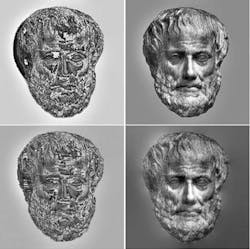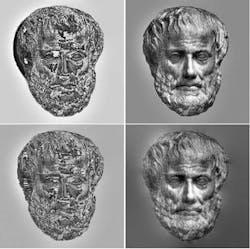Phase-unwrapping algorithm shrugs off noise
When an interferometer measures the shape of a surface by measuring a reflected or scattered wavefront, the resulting image is a two-dimensional map of the wavefront's phase. If the surface has peaks and valleys many wavelengths in height, the ideal phase map will be a replica of the surface shape that has peaks and valleys reaching many multiples of 2π in magnitude. Often, however, raw information arising from a phase measurement—for example, in speckle interferometry—exists in the form of a so-called "wrapped" phase map, in which all values lie between 0 and 2π, and which contains abrupt discontinuities of 2π magnitude (similarly, a high-quality phase-only focusing Fresnel zone plate is a "phase-wrapped" version of a refractive focusing lens).
Unwrapping phase is one of the most important steps in rendering many image-related phase measurements useful. Accurate phase-unwrapping of maps having steep phase variations (and therefore many discontinuities) is key not only to interferometry, but also to adaptive optics, magnetic-resonance imaging, synthetic-aperture radar, and optical holography. Wrapped phase maps can contain not only closely spaced discontinuities, but also phase vortices (features in which a closed-loop excursion around a point produces a 2π difference in phase) and noise, causing problems for conventional phase-unwrapping algorithms. Conventional algorithms—which are based on one-dimensional column-by-column or row-by-row operations—have trouble when they operate at minimum kernel sizes of below 3 × 3 pixels, and in general present a tradeoff between kernel size and accuracy of phase unwrapping.
In contrast, a deterministic phase-unwrapping scheme developed by Vyacheslav Volkov and Yimei Zhu of Brookhaven National Laboratory (BNL; Upton, NY) requires no such tradeoff and works with kernels down to the theoretically smallest 1 × 2–pixel size.1 The scheme, which is intrinsically two-dimensional and based on an exact Fourier solution, is fast and path-independent, operating only under the necessary assumption that local phase and noise-related phase jumps do not exceed 2π per pixel. The approach requires only three Fourier transforms with a computing time of approximately 3N2logN, where N is the image size in pixels.
"The benefits of this approach become apparent for strongly undersampled data in which every pixel really matters and where phase oscillations may approach 2π per pixel," says Volkov. In one example, a wrapped phase map with oscillations as high as 2π per every 1.5 pixels is unwrapped successfully by the BNL algorithm and unsuccessfully by a conventional approach (see figure). The efficiency of the algorithm allows the unwrapping of a 512 × 512–pixel phase map within a few seconds on a slow (500-MHz) personal computer. On a more-capable computer, the algorithm will be useful in astronomical adaptive optics, in which corrections for atmospheric turbulence must be calculated in real time.
REFERENCE
1. V. V. Volkov and Y. Zhu, Optics Lett. 28(22) (Nov. 25, 2003).

